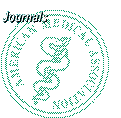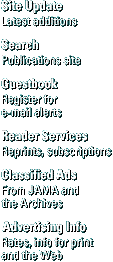


Week of May 20, 1998
American Medical Association Science News Updates are made available to the
public after 3 p.m. Central time (U.S.) on the first four Tuesdays of each
month. We keep some back issues on this issue and have a list of available releases.
THIS WEEK'S CONTENTS
JAMA REPORTS
- U.S. Drug Safety Monitoring Must Be Expanded
U.S. DRUG SAFETY MONITORING MUST BE EXPANDED
Commentary
calls for pharmaceutical companies to provide
ing for enhanced safety program
CHICAGO—The nation needs an office of drug safety with the authority,
independence, funding, and legal mandate to undertake all the responsibilities
of drug safety monitoring, according to a commentary in the May 20 issue of The
Journal of the American Medical Association (JAMA).
Thomas J. Moore of the Center for Health Policy Research at George
Washington University Medical Center in Washington, D.C., and colleagues, note
that an estimated 1.5 million people require hospitalization and 100,000 die
each year because of injuries linked to prescription drugs. Overall, 51 percent
of approved drugs have serious adverse effects which are not detected prior to
approval. They point out that the diet drug fenfluramine was approved 24 years
before studies on heart valve damage prompted the Food and Drug Administration
(FDA) to pull it from the market.
The authors write that an effective program to protect the American public
from the health risks of marketed drugs should address four specific tasks:
Estimating the number and cause of serious injuries and deaths. Without
this information, it is impossible to determine if serious injuries associated
with adverse effects of prescription drugs are declining, or if an epidemic of
drug-induced injury may be taking place. The authors write: "It makes no
more sense to monitor drug safety without knowing the extent of serious injuries
than to have a National Highway Transportation Safety Administration operating
without information about automobile accidents, or a Federal Aviation
Administration not knowing how many airplane crashes have occurred."
Identifying new serious reactions. The FDA's Division of Pharmacovigilance
and Epidemiology (DPE) devotes most of its staff and resources to this task.
Reports of adverse reactions to recently marketed drugs are collected from
consumers, physicians, pharmacists, nurses, and other health professionals. But
the authors point out that the FDA estimates only about one percent of adverse
events are ever reported. And they add: "A spontaneous reporting system
also cannot capture adverse effects that manifest themselves as a disease with
high prevalence or with a long delay between exposure and clinical
manifestations. Cancer is the classic example."
Monitoring the effect of previous safety alerts. The FDA has no organized
program to check whether important warning messages about product labeling about
drug use are being heeded. But the limited information available suggests that
some warnings are not received, or have little effect. The authors write: "It
is important to discover why important safety warnings are not being heeded.
Are 'Dear Doctor' letters and label changes being lost in the avalanche of
pharmaceutical marketing and advertising information being sent to the
physician's office? Or do physicians disbelieve the message?"
Operating an early-warning system. Rather than waiting passively for
spontaneous reports of adverse reactions, the authors say active surveillance is
needed to check for sensitive indicators of possible problems: "In
particular, regular monitoring is needed to check for drug involvement in
reported cases of birth defects, agranulocytosis, a disorder primarily caused by
drugs, and aplastic anemia, which is frequently caused by drugs. So many
drugs--including tricyclic antidepressants, agents for migraine headaches, diet
drugs, class I antiarrhythmics, non-sedating antihistamines, and cardiac
glycosides--have been linked to arrhythmia and other cardiac effects that a
cardiac early-warning system may also be warranted."
The authors propose that funding for an expanded drug safety program should
come from user fees collected from pharmaceutical companies: "The drug
industry should be no less liable for the costs of its safety regulation than
the nuclear power industry, which pays for the full costs of the Nuclear
Regulatory Commission. Even if the pharmaceutical industry, already the
nation's most profitable as measured by return on investment, passes on the
whole burden to consumers, the added cost would be small. Just one penny per
prescription would yield approximately $24 million for an enhanced drug safety
monitoring program."
They conclude: "This investment in drug safety has the potential to
save thousands of lives and prevent tens of thousands of serious injuries every
year."
(JAMA. 1998; 279:1571-1573)